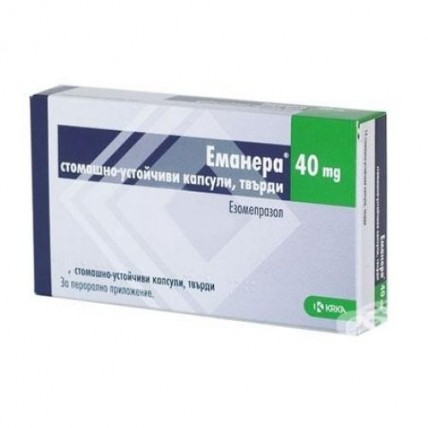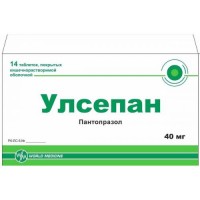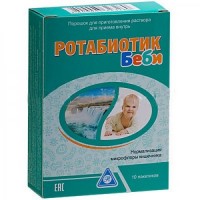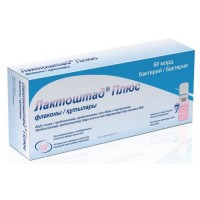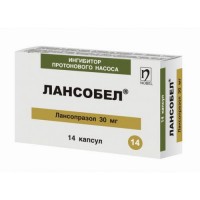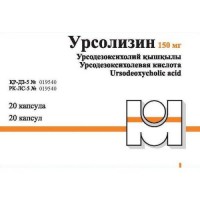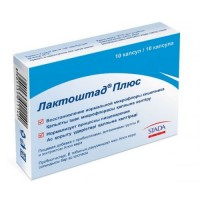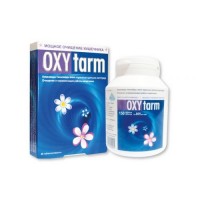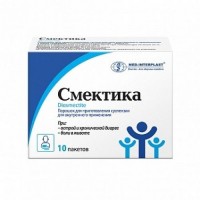The instruction for medical use
of EMANERA® medicine
Trade name
ЭМАНЕРА®
the International unlicensed
name Esomeprazole Dosage Form
of the Capsule kishechnorastvorimy 20 mg and 40 mg
Structure
One capsule contains
active agent - esomeprazole of magnesium of 20.645 mg and 41.290 mg (it is equivalent
to esomeprazole of 20 mg and 40 mg respectively),
excipients: sugar granules (spheres), K30 povidone, sodium lauryl sulfate, Opadry II White 85F28751 (polyvinyl alcohol, the titan dioxide (E 171), a macrogoal 3000, talc), magnesium a carbonate heavy, methacrylic acid – ethyl acrylate copolymer (1: 1) dispersion of 30%, talc, macrogoal 6000, titan dioxide (E 171), polysorbate 80,
structure of a cover of the capsule: gland (III) oxide red (E 172), titan dioxide (E 171), gelatin.
The description
of the Capsule with the body and a lid of slightly pinkish color. Contents of capsules - pellets of white or almost white color (for a dosage of 20 mg).
Capsules with the body and a lid of almost pink color. Contents of capsules -
pellets of white or almost white color (for a dosage of 40 mg).
Pharmacotherapeutic group
Antiulcerous drugs and drugs for treatment of a gastroesophageal reflux (GORD). Inhibitors of the protonew pump.
The ATX A02BC05 code
the Pharmacological
Pharmacokinetics Esomeprazole properties is unstable in acidic environment and is accepted orally in the form of the granules covered with a kishechnorastvorimy cover. Absorption of esomeprazole happens quickly, the plasma peak comes in 1-2 hours after reception. The absolute bioavailability is 64% after a single dose in 40 mg and increases up to 89% after repeated use of a single dose. For 20 mg of esomeprazole, the corresponding values are 50% and 68%, respectively. The expressed volume of distribution in steady state at healthy people is about 0.221/kg body weights. Esomeprazole contacts proteins of plasma for 97%.
Meal both detains, and reduces esomeprazole absorption though it has no significant effect on efficiency of inhibition of secretion of hydrochloric acid.
Metabolism and removal
Esomeprazole is completely metabolized with participation of a system of P450 cytochrome (CYP). The main part is metabolized with the participation of polymorphic CYP2C19 which is responsible for formation of hydroxy - and esomeprazole desmetilmetabolit. Metabolism of the rest depends on other specific isoform, CYP3A4 which is responsible for education sulphone esomeprazole - the main metabolite in blood plasma.
The parameters specified below reflect, generally the nature of pharmacokinetics at patients with active CYP2C19 enzyme (at patients with extensive metabolism). The general plasma clearance is about 17 l/h after single dose of drug and 9 l/h – at repeated receptions. Elimination half-life makes 1.3 hours at repeated administrations of drug once a day. At intake of esomeprazole in a dose of 40 mg two times a day, the area under a curve concentration – time (AUC) increases at repeated administration of esomeprazole. This increase is dose-dependent and leads to more than dozoproportsionalny increase in AUC after repeated introduction. This time - and dozo-dependence is explained by decrease in metabolism at the first passing through a liver and also decrease in system clearance of esomeprazole that is probably connected with CYP2C19 enzyme inhibition esomeprazole and/or its sulfonsoderzhashy metabolite.
Esomeprazole is completely removed from plasma between doses, at use once a day the tendency to cumulation of drug is not noted.
The main metabolites of esomeprazole do not influence secretion of acid in a stomach. At oral administration up to 80% of a dose of drug other part is removed in the form of metabolites with urine, - with excrements. In urine less than 1% of not changed esomeprazole are found.
The special category of patients
Approximately at 2.9 ± 1.5% of the population is reduced activity of CYP2C19 enzyme (at patients with slow metabolism). Such patients have an esomeprazole metabolism, is generally carried out by means of CYP3A4. At repeated intake of 40 mg of esomeprazole once in day average area under a curve concentration – time is 100% higher, than at patients with active CYP2C19 enzyme (patients with fast metabolism). Average values of peak concentration in plasma at patients with slow metabolism are increased approximately by 60%. Noted features do not influence a dosage and a route of administration of esomeprazole.
At patients of advanced age (71-80 years) the esomeprazole metabolism significantly does not change.
After a single dose of esomeprazole in 40 mg, the average size of the area under a curve concentration - time is about 10% higher at women, than at men. After use of repeated single doses no sexual distinctions were observed. Noted features do not influence an esomeprazole dosage.
At disturbances of functions of bodies
At patients with slight and moderate abnormal liver functions the metabolism of esomeprazole can be slowed down. At patients with heavy abnormal liver functions the speed of metabolism is reduced that concentration – time for esomeprazole leads to doubling of the area under a curve. Therefore the maximum dose of esomeprazole for patients with heavy dysfunction of bodies makes 20 mg and it should not be exceeded. The tendency to cumulation of esomeprazole and its main metabolites at administration of drug is not noted once a day.
Metabolism of esomeprazole is expected without any changes at patients with impaired renal function as kidneys are responsible for removal of metabolites of esomeprazole, but not the most initial substance.
12-18 summer patients have the general exposure (AUC) and time of achievement of the maximum concentration of drug in blood plasma (tmax) were similar to adults at reception of dosages of 20 mg and 40 mg of esomeprazole.
The pharmacodynamics
of Emanera® is S-isomer of omeprazolum and reduces secretion of acid in a stomach by the specific aimed action mechanism. Drug represents inhibitor of the protonew pump in covering cells. S- and R-isomers of omeprazolum have similar pharmakodinamichesky activity.
Esomeprazole is the weak basis, concentrates and passes into an active form in strong acidic environment of secretory tubules of covering cells and inhibits H+, K enzyme +-ATFazu – the acid pump and inhibits both basal, and stimulated secretion of acid.
Influence on secretion of acid in a stomach
After oral administration of 20 mg or 40 mg of the drug Emanera® effect develops within 1 hour. At daily administration of drug within 5 days in a dose of 20 mg once a day, average peak concentration of acid after stimulation by Pentagastrinum decreases by 90%, at measurement of concentration of acid in 6 — 7 hours after reception of a dose for the 5th day of therapy. After 5 days of oral administration of esomeprazole in a dose of 20 mg and 40 mg, rn in a stomach made higher than 4 within, on average, 13 and 17 hours, respectively, more than 24 hours at patients with the symptomatic gastroesophageal reflux disease (GRD). After intake of esomeprazole in a dose of 20 mg, rn in a stomach was higher than 4 at 76% patients within 8 hours, at 54% of patients within 12 hours and at 24% of patients within 16 hours. The corresponding ratios for esomeprazole in a dose of 40 mg made 97%, 92% and 56%.
Using the AUC parameter, as the replacing parameter for assessment of concentration of esomeprazole in plasma, the interrelation between secretion of acid and concentration of drug was revealed.
The therapeutic effect reached acid secretion inhibition Healing a reflux esophagitis by the drug Emanera® in a dose of 40 mg
is caused approximately at 78% of patients in 4 weeks and at 93% – in 8 weeks. The Emanera® drug treatment in a dose of 20 mg 2 times a day in a combination with the corresponding antibiotics within one week leads to Helicobacter pylori eradikation approximately at 90% of patients.
In an uncomplicated ulcer of a duodenum the effective healing of an ulcer after a week eradikatsionny course does not require the subsequent monotherapy by anti-secretory drugs.
Other effects connected with inhibition of secretion of acid
during treatment by anti-secretory drugs gastrin level in plasma raises as a result of decrease in secretion of acid.
At patients, the long time receiving esomeprazole, is noted increase in quantity of enterokhromaffinopodobny cells (ECL cells) probably connected with increase in level of gastrin in plasma.
Esomeprazole showed high efficiency concerning healing of stomach ulcers and also prevention of stomach ulcers and a duodenum, at the patients receiving non-steroidal anti-inflammatory drugs (including at patients 60 years and/or with a round ulcer in the anamnesis are aged more senior), including selection inhibitors of cyclooxygenase-2 (TsOG-2).
Indications
- the gastroesophageal reflux disease (GRD) (treatment erosive
a reflux esophagitis, the long-term supporting treatment after healing
a reflux esophagitis for prevention of a recurrence, symptomatic leche-
ny the gastroesophageal reflux disease
- for Helicobacter pylori eradikation in a combination with the corresponding
mode of therapy by antibiotics (treatment of an ulcer of the duodenum associated with Helicobacter pylori, prevention of a recurrence of the round ulcers associated with Helicobacter pylori)
- patients who need continuous treatment of NPVP (healing
of the stomach ulcer connected with reception of NPVP, prevention of the stomach ulcer and
a duodenum tied with reception of NPVP at patients, otno-
syashchikhsya to risk group)
- long-term treatment after the intravenous induced prevention
of a recurrence of bleeding from a round ulcer
- treatment of a syndrome of Zollinger – Ellisona
should swallow the Route of administration and doses of the Capsule entirely, washing down with a small amount of water. Capsules cannot be chewed or split up.
For patients with difficulty when swallowing, capsules can be opened and to dissolve pellets in half of glass of still water. It is not necessary to use other liquids as the protective cover can be dissolved. Water with microgranules is drunk at once or within 30 minutes. Again fill a glass with water half, stir the remains and drink. It is not necessary to chew or split up microgranules.
Patients who cannot swallow capsules can open and dissolve pellets in still water, then to enter via the probe. It is important that the expediency of administration of drug by means of the syringe and a tube, was carefully considered.
To adults and teenagers since 12 years
the Gastroesophageal reflux disease
Treatment erosive a reflux esophagitis: 40 mg once in day within 4 weeks. The additional 4-week course of treatment is recommended in cases if after the first course, healing of an esophagitis does not occur or symptoms remain.
The long-term supporting treatment of patients with the cured esophagitis for prevention of a recurrence: on 20 mg once a day.
Symptomatic treatment of a gastroesophageal reflux disease: 20 mg once a day to patients without esophagitis. If after 4 weeks of treatment the symptoms do not disappear, it is necessary to perform additional examination of the patient. After elimination of symptoms, the subsequent control of symptoms is reached by administration of drug in a dose of 20 mg once a day. Adults, if necessary, can use the therapy on demand mode of administration of drug in a dose of 20 mg once a day. To the patients receiving treatment of NPVP with risk of developing stomach ulcer and a duodenum, the subsequent control of symptoms with use of the therapy on demand mode, is not recommended.
The adult
For Helicobacter pylori eradikation in a combination with the corresponding mode of therapy by antibiotics
Treatment of an ulcer of the duodenum associated with Helicobacter pylori and prevention of a recurrence of round ulcers at patients with Helicobacter pylori-associated ulcers: 20 mg of Emanera® in a combination from 1 g of amoxicillin and 500 mg of a klarimitrotsin, all drugs are taken 2 times a day within 7 days.
Patients who need continuous treatment of NPVP
Healing of the stomach ulcer connected with reception of NPVP: a usual dose of 20 mg of 1 times a day. Duration of treatment is 4–8 weeks.
Prevention of the stomach ulcer and a duodenum tied with reception of NPVP at patients with risk: 20 mg of 1 times a day.
Long-term treatment after the intravenous induced prevention of a recurrence of bleeding from a round ulcer: 40 mg of 1 times a day within 4 weeks after the intravenous induced prevention of a recurrence of bleeding from a round ulcer.
Treatment of a syndrome of Zollinger - Ellisona: the recommended initial dose of Emanera® makes 40 mg two times a day. Then the dosage should be selected individually, duration of treatment is determined by a clinical picture of a disease. On the basis of clinical data, conditions of most of patients can be controlled receptions of doses from 80 to 160 mg of esomeprazole a day. At doses it is higher than 80 mg daily, it is necessary to divide and accept a dose two times a day.
To children 12 years are younger it is not necessary to appoint Emaner due to the lack of data on safety.
With impaired renal function the dose adjustment is not required from patients. Because of limited experience among patients with a heavy renal failure, it is necessary to be careful at treatment of such patients.
With a slight and moderate liver failure the dose adjustment is not required from patients. For patients with a heavy liver failure, the maximum daily dose should not exceed 20 mg.
Dose adjustment is not required from elderly patients.
Do not eat capsule dehumidifier which contains in a container!
Side effects
Often (≥1/100, & lt, 1/10)
- a headache
- an abdominal pain, a meteorism, nausea, vomiting a constipation, diarrhea
Infrequently (≥1/1.000, & lt, 1/100)
- peripheral swell
- insomnia
- dizziness, paresthesia, a sleep disorder (drowsiness)
- vertigo
- dryness in a mouth
- increase in activity of enzymes of a liver
- dermatitis, an itching, rash, urticaria
Seldom (≥1/10.000, & lt, 1/1000)
- a leukopenia, thrombocytopenia
- reactions of hypersensitivity (fever, a Quincke's edema and anafilakti-
chesky reactions / shock)
- a hyponatremia
- concern, confusion of consciousness, a depression, an indisposition
- disturbance of taste
- indistinct sight
- a bronchospasm
- stomatitis, gastrointestinal candidiasis
- hepatitis with jaundice or without
- an alopecia, a photosensitization
- an arthralgia, myalgia
- an indisposition, the increased sweating
is Very rare (& lt, 1/10,000)
- an agranulocytosis, a pancytopenia
- a liver failure, encephalopathy at patients with already sushches-
a tvuyushchy serious illness of a liver
- a multiformny erythema, Stephens-Johnson's syndrome, a toxic
epidermal necrolysis
- muscle weakness
- interstitial nephrite
- a gynecomastia
- a gipomagneziyemiya
- hallucinations, agressive behavior (mainly, at the weakened
patients)
Contraindications
- hypersensitivity to esomeprazole, the replaced benzimidazo-
lamas or other components of drug
- combined use with atazanaviry
- pregnancy and the period of a lactation
- children's and teenage age up to 12 years (the efficiency and safety
is not studied)
Medicinal interactions
of Impact of esomeprazole on pharmacokinetics of other drugs
Medicines with rn-dependent release
the Lowered acidity in a stomach at treatment by esomeprazole can lead to decrease or increase in absorption of other drugs which mechanism of absorption depends on acidity of the environment. As well as when using other drugs suppressing secretion of acid or antacids, treatment by esomeprazole can lead to decrease in absorption of a ketokonazol or itrakonazol.
Simultaneous use of esomeprazole (40 mg once a day) from atazanaviry 300 mg / leads ritonaviry 100 mg to decrease in exposure of an atazanavir (approximately AUC (the area of a curve 'concentration - time'), Cmax and Cmin (the maximum and minimum concentration in plasma decreases by 75%). Increase in a dose of an atazanavir to 400 mg does not compensate influence of esomeprazole on exposure of an atazanavir. Esomeprazole, as well as other IPP (inhibitors of ' proton pomp '), it is not necessary to accept together with atazanaviry.
Drugs, metaboliziruyemy CYP2C19
Esomeprazole inhibits CYP2C19 – the main enzyme of esomeprazole participating in his metabolism. Respectively, combined use of esomeprazole with other drugs in which metabolism CYP2C19, such as diazepam, to tsitalopra, Imipraminum, klomipramin, Phenytoinum, etc. takes part can lead to increase in concentration of these drugs in plasma and demand a dose decline. This phenomenon is especially expressed when using esomeprazole in the mode 'to therapy on demand'. Joint reception of 30 mg of esomeprazole reduces clearance by 45% enzyme - a substrate complex (CYP2C19 diazepam substrate), joint reception of 40 mg of esomeprazole increases residual concentration of Phenytoinum in plasma at patients with epilepsy in this connection control of concentration of Phenytoinum in plasma in an initiation of treatment is recommended by esomeprazole and at its cancellation by 13%. Esomeprazole (40 mg a day) concentration - time' a vorikonazol (CYP2C19 substrate) increases the maximum concentration and the area of a curve by 15% and 41% respectively '.
With warfarin in isolated cases INR (the international normalized ratio) can lead simultaneous use for patients of 40 mg of esomeprazole to clinically significant increase. It is recommended to control a condition of the patient at the beginning and at the end of the accompanying therapy by esomeprazole with warfarin or other derivatives of coumarin.
Joint reception of 40 mg of esomeprazole increased area size under a curve by 32% 'concentration in plasma – time' (AUC) and increased elimination half-life (t1/2) by 31%, but did not change peak concentration of a tsizaprid in plasma. Insignificant lengthening of an interval of QT which was observed at monotherapy use tsizapridy at a combination with esomeprazole, did not increase.
Esomeprazole does not cause clinically significant changes of pharmacokinetics of amoxicillin, quinidine.
Combined use of esomeprazole and Naproxenum or a rofekoksib did not reveal clinically significant pharmacokinetic interaction. CYP2C19 and CYP3A4 take part in metabolism of esomeprazole. Combined use of esomeprazole with CYP3A4 inhibitor, klaritromitsiny (500 mg twice a day) leads to double increase in AUC value in relation to esomeprazole. Combined use of esomeprazole and the combined CYP3A4 and CYP3A4 inhibitor can lead to double increase in concentration of esomeprazole. Combined use of esomeprazole and the combined CYP3A4 and CYP2C19 inhibitor of a vorikonazol increases AUC values for omeprazolum by 280%. As a rule, in such cases the esomeprazole dose adjustment is not required. However, dose adjustment of esomeprazole should be carried out at patients with a heavy abnormal liver function and at its prolonged use.
Special instructions
in the presence of any disturbing symptoms (for example, such as considerable spontaneous loss of body weight, frequent vomiting, a dysphagy, vomiting with blood or a melena) and also in the presence of stomach ulcer (or at suspicion of stomach ulcer), it is necessary to exclude existence of a malignant new growth as the Emanera® drug treatment can lead to smoothing of symptomatology and delay diagnosis.
The patients taking the drug Emanera® during the long period (especially over a year) have to be under regular observation of the doctor.
The patients who are on the therapy mode on demand have to be instructed about need to contact the doctor at change of nature of symptoms. In view of fluctuations of concentration of esomeprazole in blood plasma when prescribing esomeprazole in the therapy mode on demand, it is necessary to consider interaction of drug with other medicines.
At patients, the long time receiving esomeprazole, is noted increase in quantity of enterokhromaffinopodobny (ECL) cells probably connected with increase in level of gastrin in plasma, at the patients taking the anti-secretory drugs during a long period the formation of benign ferruterous cysts in a stomach is more often noted. These phenomena are caused by physiological changes in result of the expressed inhibition of secretion of acid and have reversible character.
Decrease in acidity of gastric juice in any ways, including inhibitors of the proton pump, increases quantity of the gastric bacteria which are usually present at digestive tract. Treatment by inhibitors of the proton pump can lead to insignificant increase in risk of gastrointestinal infections, such as Salmonella and Campylobacter.
When prescribing the drug Emanera® for an eradikation of Helicobacter pylori the possibility of medicinal interactions for all components of triple therapy has to be considered. Klaritromitsin - powerful CYP3A4 inhibitor, therefore, all contraindications and interactions of a klaritromitsin in case of use for the patients taking other medicine which is metabolized with participation of CYP3A4 have to be considered (for example, tsizaprid).
Эманера® contains sucrose. Patients with hereditary intolerance of fructose, glyukozo-galaktozny malabsorption or sakharazo-izomaltazny insufficiency should not take this drug.
Pregnancy and a lactation
Clinical data on influence of esomeprazole at pregnancy are insufficient.
Now it is unknown whether esomeprazole with breast milk is emitted. Researches at the feeding women were not conducted. Therefore Emaner should not appoint during breastfeeding.
The feature of influence of medicine on ability to run the vehicle or potentially dangerous
Emanera® mechanisms does not affect ability of control of vehicles and work with mechanisms.
Simtoma's overdose: the general weakness strengthening of side effects, including from digestive tract.
Treatment: the symptomatic and supporting treatment. Dialysis is ineffective. Specific antidotes are unknown.
The form of release and packing
On 5, 7 or 10 capsules place in blister strip packaging from OPA/Al/PE film + DES or OPA/Al/PVC and aluminum foil.
On 3 blister strip packagings (on 5 capsules), on 1, 2, 4 or 8 blister strip packagings (on 7 capsules) or on 3 and 6 blister strip packagings (on 10 capsules) together with the instruction for medical use in the state and Russian languages place in a pack from cardboard.
To Store storage conditions in original packing at a temperature not over 30 ºС.
To store out of children's reach!
A period of storage
2 years
Prescription status
According to the prescription
the Producer
of KRK, of. The place is new, Slovenia
Shmaryeshka 6, 8501 the Place, Slovenia
the Name and the country of the owner of the registration certificate
of KRK, of Is new, the Place, Slovenia
the Address of the organization accepting in the territory of the Republic of Kazakhstan claims from consumers on quality of products (goods) Representation KRKA, tovarna zdravil, d.d., Novo mesto in RKRK, 050059, Almaty, Al-Farabi Ave., 19 Is new, body 1B, 2 etazhtet. 8 (727) 311-08-09факс 8 (727) 311-08-12www.krka.si
to Develop
of EMANERA® medicine
Trade name
ЭМАНЕРА®
the International unlicensed
name Esomeprazole Dosage Form
of the Capsule kishechnorastvorimy 20 mg and 40 mg
Structure
One capsule contains
active agent - esomeprazole of magnesium of 20.645 mg and 41.290 mg (it is equivalent
to esomeprazole of 20 mg and 40 mg respectively),
excipients: sugar granules (spheres), K30 povidone, sodium lauryl sulfate, Opadry II White 85F28751 (polyvinyl alcohol, the titan dioxide (E 171), a macrogoal 3000, talc), magnesium a carbonate heavy, methacrylic acid – ethyl acrylate copolymer (1: 1) dispersion of 30%, talc, macrogoal 6000, titan dioxide (E 171), polysorbate 80,
structure of a cover of the capsule: gland (III) oxide red (E 172), titan dioxide (E 171), gelatin.
The description
of the Capsule with the body and a lid of slightly pinkish color. Contents of capsules - pellets of white or almost white color (for a dosage of 20 mg).
Capsules with the body and a lid of almost pink color. Contents of capsules -
pellets of white or almost white color (for a dosage of 40 mg).
Pharmacotherapeutic group
Antiulcerous drugs and drugs for treatment of a gastroesophageal reflux (GORD). Inhibitors of the protonew pump.
The ATX A02BC05 code
the Pharmacological
Pharmacokinetics Esomeprazole properties is unstable in acidic environment and is accepted orally in the form of the granules covered with a kishechnorastvorimy cover. Absorption of esomeprazole happens quickly, the plasma peak comes in 1-2 hours after reception. The absolute bioavailability is 64% after a single dose in 40 mg and increases up to 89% after repeated use of a single dose. For 20 mg of esomeprazole, the corresponding values are 50% and 68%, respectively. The expressed volume of distribution in steady state at healthy people is about 0.221/kg body weights. Esomeprazole contacts proteins of plasma for 97%.
Meal both detains, and reduces esomeprazole absorption though it has no significant effect on efficiency of inhibition of secretion of hydrochloric acid.
Metabolism and removal
Esomeprazole is completely metabolized with participation of a system of P450 cytochrome (CYP). The main part is metabolized with the participation of polymorphic CYP2C19 which is responsible for formation of hydroxy - and esomeprazole desmetilmetabolit. Metabolism of the rest depends on other specific isoform, CYP3A4 which is responsible for education sulphone esomeprazole - the main metabolite in blood plasma.
The parameters specified below reflect, generally the nature of pharmacokinetics at patients with active CYP2C19 enzyme (at patients with extensive metabolism). The general plasma clearance is about 17 l/h after single dose of drug and 9 l/h – at repeated receptions. Elimination half-life makes 1.3 hours at repeated administrations of drug once a day. At intake of esomeprazole in a dose of 40 mg two times a day, the area under a curve concentration – time (AUC) increases at repeated administration of esomeprazole. This increase is dose-dependent and leads to more than dozoproportsionalny increase in AUC after repeated introduction. This time - and dozo-dependence is explained by decrease in metabolism at the first passing through a liver and also decrease in system clearance of esomeprazole that is probably connected with CYP2C19 enzyme inhibition esomeprazole and/or its sulfonsoderzhashy metabolite.
Esomeprazole is completely removed from plasma between doses, at use once a day the tendency to cumulation of drug is not noted.
The main metabolites of esomeprazole do not influence secretion of acid in a stomach. At oral administration up to 80% of a dose of drug other part is removed in the form of metabolites with urine, - with excrements. In urine less than 1% of not changed esomeprazole are found.
The special category of patients
Approximately at 2.9 ± 1.5% of the population is reduced activity of CYP2C19 enzyme (at patients with slow metabolism). Such patients have an esomeprazole metabolism, is generally carried out by means of CYP3A4. At repeated intake of 40 mg of esomeprazole once in day average area under a curve concentration – time is 100% higher, than at patients with active CYP2C19 enzyme (patients with fast metabolism). Average values of peak concentration in plasma at patients with slow metabolism are increased approximately by 60%. Noted features do not influence a dosage and a route of administration of esomeprazole.
At patients of advanced age (71-80 years) the esomeprazole metabolism significantly does not change.
After a single dose of esomeprazole in 40 mg, the average size of the area under a curve concentration - time is about 10% higher at women, than at men. After use of repeated single doses no sexual distinctions were observed. Noted features do not influence an esomeprazole dosage.
At disturbances of functions of bodies
At patients with slight and moderate abnormal liver functions the metabolism of esomeprazole can be slowed down. At patients with heavy abnormal liver functions the speed of metabolism is reduced that concentration – time for esomeprazole leads to doubling of the area under a curve. Therefore the maximum dose of esomeprazole for patients with heavy dysfunction of bodies makes 20 mg and it should not be exceeded. The tendency to cumulation of esomeprazole and its main metabolites at administration of drug is not noted once a day.
Metabolism of esomeprazole is expected without any changes at patients with impaired renal function as kidneys are responsible for removal of metabolites of esomeprazole, but not the most initial substance.
12-18 summer patients have the general exposure (AUC) and time of achievement of the maximum concentration of drug in blood plasma (tmax) were similar to adults at reception of dosages of 20 mg and 40 mg of esomeprazole.
The pharmacodynamics
of Emanera® is S-isomer of omeprazolum and reduces secretion of acid in a stomach by the specific aimed action mechanism. Drug represents inhibitor of the protonew pump in covering cells. S- and R-isomers of omeprazolum have similar pharmakodinamichesky activity.
Esomeprazole is the weak basis, concentrates and passes into an active form in strong acidic environment of secretory tubules of covering cells and inhibits H+, K enzyme +-ATFazu – the acid pump and inhibits both basal, and stimulated secretion of acid.
Influence on secretion of acid in a stomach
After oral administration of 20 mg or 40 mg of the drug Emanera® effect develops within 1 hour. At daily administration of drug within 5 days in a dose of 20 mg once a day, average peak concentration of acid after stimulation by Pentagastrinum decreases by 90%, at measurement of concentration of acid in 6 — 7 hours after reception of a dose for the 5th day of therapy. After 5 days of oral administration of esomeprazole in a dose of 20 mg and 40 mg, rn in a stomach made higher than 4 within, on average, 13 and 17 hours, respectively, more than 24 hours at patients with the symptomatic gastroesophageal reflux disease (GRD). After intake of esomeprazole in a dose of 20 mg, rn in a stomach was higher than 4 at 76% patients within 8 hours, at 54% of patients within 12 hours and at 24% of patients within 16 hours. The corresponding ratios for esomeprazole in a dose of 40 mg made 97%, 92% and 56%.
Using the AUC parameter, as the replacing parameter for assessment of concentration of esomeprazole in plasma, the interrelation between secretion of acid and concentration of drug was revealed.
The therapeutic effect reached acid secretion inhibition Healing a reflux esophagitis by the drug Emanera® in a dose of 40 mg
is caused approximately at 78% of patients in 4 weeks and at 93% – in 8 weeks. The Emanera® drug treatment in a dose of 20 mg 2 times a day in a combination with the corresponding antibiotics within one week leads to Helicobacter pylori eradikation approximately at 90% of patients.
In an uncomplicated ulcer of a duodenum the effective healing of an ulcer after a week eradikatsionny course does not require the subsequent monotherapy by anti-secretory drugs.
Other effects connected with inhibition of secretion of acid
during treatment by anti-secretory drugs gastrin level in plasma raises as a result of decrease in secretion of acid.
At patients, the long time receiving esomeprazole, is noted increase in quantity of enterokhromaffinopodobny cells (ECL cells) probably connected with increase in level of gastrin in plasma.
Esomeprazole showed high efficiency concerning healing of stomach ulcers and also prevention of stomach ulcers and a duodenum, at the patients receiving non-steroidal anti-inflammatory drugs (including at patients 60 years and/or with a round ulcer in the anamnesis are aged more senior), including selection inhibitors of cyclooxygenase-2 (TsOG-2).
Indications
- the gastroesophageal reflux disease (GRD) (treatment erosive
a reflux esophagitis, the long-term supporting treatment after healing
a reflux esophagitis for prevention of a recurrence, symptomatic leche-
ny the gastroesophageal reflux disease
- for Helicobacter pylori eradikation in a combination with the corresponding
mode of therapy by antibiotics (treatment of an ulcer of the duodenum associated with Helicobacter pylori, prevention of a recurrence of the round ulcers associated with Helicobacter pylori)
- patients who need continuous treatment of NPVP (healing
of the stomach ulcer connected with reception of NPVP, prevention of the stomach ulcer and
a duodenum tied with reception of NPVP at patients, otno-
syashchikhsya to risk group)
- long-term treatment after the intravenous induced prevention
of a recurrence of bleeding from a round ulcer
- treatment of a syndrome of Zollinger – Ellisona
should swallow the Route of administration and doses of the Capsule entirely, washing down with a small amount of water. Capsules cannot be chewed or split up.
For patients with difficulty when swallowing, capsules can be opened and to dissolve pellets in half of glass of still water. It is not necessary to use other liquids as the protective cover can be dissolved. Water with microgranules is drunk at once or within 30 minutes. Again fill a glass with water half, stir the remains and drink. It is not necessary to chew or split up microgranules.
Patients who cannot swallow capsules can open and dissolve pellets in still water, then to enter via the probe. It is important that the expediency of administration of drug by means of the syringe and a tube, was carefully considered.
To adults and teenagers since 12 years
the Gastroesophageal reflux disease
Treatment erosive a reflux esophagitis: 40 mg once in day within 4 weeks. The additional 4-week course of treatment is recommended in cases if after the first course, healing of an esophagitis does not occur or symptoms remain.
The long-term supporting treatment of patients with the cured esophagitis for prevention of a recurrence: on 20 mg once a day.
Symptomatic treatment of a gastroesophageal reflux disease: 20 mg once a day to patients without esophagitis. If after 4 weeks of treatment the symptoms do not disappear, it is necessary to perform additional examination of the patient. After elimination of symptoms, the subsequent control of symptoms is reached by administration of drug in a dose of 20 mg once a day. Adults, if necessary, can use the therapy on demand mode of administration of drug in a dose of 20 mg once a day. To the patients receiving treatment of NPVP with risk of developing stomach ulcer and a duodenum, the subsequent control of symptoms with use of the therapy on demand mode, is not recommended.
The adult
For Helicobacter pylori eradikation in a combination with the corresponding mode of therapy by antibiotics
Treatment of an ulcer of the duodenum associated with Helicobacter pylori and prevention of a recurrence of round ulcers at patients with Helicobacter pylori-associated ulcers: 20 mg of Emanera® in a combination from 1 g of amoxicillin and 500 mg of a klarimitrotsin, all drugs are taken 2 times a day within 7 days.
Patients who need continuous treatment of NPVP
Healing of the stomach ulcer connected with reception of NPVP: a usual dose of 20 mg of 1 times a day. Duration of treatment is 4–8 weeks.
Prevention of the stomach ulcer and a duodenum tied with reception of NPVP at patients with risk: 20 mg of 1 times a day.
Long-term treatment after the intravenous induced prevention of a recurrence of bleeding from a round ulcer: 40 mg of 1 times a day within 4 weeks after the intravenous induced prevention of a recurrence of bleeding from a round ulcer.
Treatment of a syndrome of Zollinger - Ellisona: the recommended initial dose of Emanera® makes 40 mg two times a day. Then the dosage should be selected individually, duration of treatment is determined by a clinical picture of a disease. On the basis of clinical data, conditions of most of patients can be controlled receptions of doses from 80 to 160 mg of esomeprazole a day. At doses it is higher than 80 mg daily, it is necessary to divide and accept a dose two times a day.
To children 12 years are younger it is not necessary to appoint Emaner due to the lack of data on safety.
With impaired renal function the dose adjustment is not required from patients. Because of limited experience among patients with a heavy renal failure, it is necessary to be careful at treatment of such patients.
With a slight and moderate liver failure the dose adjustment is not required from patients. For patients with a heavy liver failure, the maximum daily dose should not exceed 20 mg.
Dose adjustment is not required from elderly patients.
Do not eat capsule dehumidifier which contains in a container!
Side effects
Often (≥1/100, & lt, 1/10)
- a headache
- an abdominal pain, a meteorism, nausea, vomiting a constipation, diarrhea
Infrequently (≥1/1.000, & lt, 1/100)
- peripheral swell
- insomnia
- dizziness, paresthesia, a sleep disorder (drowsiness)
- vertigo
- dryness in a mouth
- increase in activity of enzymes of a liver
- dermatitis, an itching, rash, urticaria
Seldom (≥1/10.000, & lt, 1/1000)
- a leukopenia, thrombocytopenia
- reactions of hypersensitivity (fever, a Quincke's edema and anafilakti-
chesky reactions / shock)
- a hyponatremia
- concern, confusion of consciousness, a depression, an indisposition
- disturbance of taste
- indistinct sight
- a bronchospasm
- stomatitis, gastrointestinal candidiasis
- hepatitis with jaundice or without
- an alopecia, a photosensitization
- an arthralgia, myalgia
- an indisposition, the increased sweating
is Very rare (& lt, 1/10,000)
- an agranulocytosis, a pancytopenia
- a liver failure, encephalopathy at patients with already sushches-
a tvuyushchy serious illness of a liver
- a multiformny erythema, Stephens-Johnson's syndrome, a toxic
epidermal necrolysis
- muscle weakness
- interstitial nephrite
- a gynecomastia
- a gipomagneziyemiya
- hallucinations, agressive behavior (mainly, at the weakened
patients)
Contraindications
- hypersensitivity to esomeprazole, the replaced benzimidazo-
lamas or other components of drug
- combined use with atazanaviry
- pregnancy and the period of a lactation
- children's and teenage age up to 12 years (the efficiency and safety
is not studied)
Medicinal interactions
of Impact of esomeprazole on pharmacokinetics of other drugs
Medicines with rn-dependent release
the Lowered acidity in a stomach at treatment by esomeprazole can lead to decrease or increase in absorption of other drugs which mechanism of absorption depends on acidity of the environment. As well as when using other drugs suppressing secretion of acid or antacids, treatment by esomeprazole can lead to decrease in absorption of a ketokonazol or itrakonazol.
Simultaneous use of esomeprazole (40 mg once a day) from atazanaviry 300 mg / leads ritonaviry 100 mg to decrease in exposure of an atazanavir (approximately AUC (the area of a curve 'concentration - time'), Cmax and Cmin (the maximum and minimum concentration in plasma decreases by 75%). Increase in a dose of an atazanavir to 400 mg does not compensate influence of esomeprazole on exposure of an atazanavir. Esomeprazole, as well as other IPP (inhibitors of ' proton pomp '), it is not necessary to accept together with atazanaviry.
Drugs, metaboliziruyemy CYP2C19
Esomeprazole inhibits CYP2C19 – the main enzyme of esomeprazole participating in his metabolism. Respectively, combined use of esomeprazole with other drugs in which metabolism CYP2C19, such as diazepam, to tsitalopra, Imipraminum, klomipramin, Phenytoinum, etc. takes part can lead to increase in concentration of these drugs in plasma and demand a dose decline. This phenomenon is especially expressed when using esomeprazole in the mode 'to therapy on demand'. Joint reception of 30 mg of esomeprazole reduces clearance by 45% enzyme - a substrate complex (CYP2C19 diazepam substrate), joint reception of 40 mg of esomeprazole increases residual concentration of Phenytoinum in plasma at patients with epilepsy in this connection control of concentration of Phenytoinum in plasma in an initiation of treatment is recommended by esomeprazole and at its cancellation by 13%. Esomeprazole (40 mg a day) concentration - time' a vorikonazol (CYP2C19 substrate) increases the maximum concentration and the area of a curve by 15% and 41% respectively '.
With warfarin in isolated cases INR (the international normalized ratio) can lead simultaneous use for patients of 40 mg of esomeprazole to clinically significant increase. It is recommended to control a condition of the patient at the beginning and at the end of the accompanying therapy by esomeprazole with warfarin or other derivatives of coumarin.
Joint reception of 40 mg of esomeprazole increased area size under a curve by 32% 'concentration in plasma – time' (AUC) and increased elimination half-life (t1/2) by 31%, but did not change peak concentration of a tsizaprid in plasma. Insignificant lengthening of an interval of QT which was observed at monotherapy use tsizapridy at a combination with esomeprazole, did not increase.
Esomeprazole does not cause clinically significant changes of pharmacokinetics of amoxicillin, quinidine.
Combined use of esomeprazole and Naproxenum or a rofekoksib did not reveal clinically significant pharmacokinetic interaction. CYP2C19 and CYP3A4 take part in metabolism of esomeprazole. Combined use of esomeprazole with CYP3A4 inhibitor, klaritromitsiny (500 mg twice a day) leads to double increase in AUC value in relation to esomeprazole. Combined use of esomeprazole and the combined CYP3A4 and CYP3A4 inhibitor can lead to double increase in concentration of esomeprazole. Combined use of esomeprazole and the combined CYP3A4 and CYP2C19 inhibitor of a vorikonazol increases AUC values for omeprazolum by 280%. As a rule, in such cases the esomeprazole dose adjustment is not required. However, dose adjustment of esomeprazole should be carried out at patients with a heavy abnormal liver function and at its prolonged use.
Special instructions
in the presence of any disturbing symptoms (for example, such as considerable spontaneous loss of body weight, frequent vomiting, a dysphagy, vomiting with blood or a melena) and also in the presence of stomach ulcer (or at suspicion of stomach ulcer), it is necessary to exclude existence of a malignant new growth as the Emanera® drug treatment can lead to smoothing of symptomatology and delay diagnosis.
The patients taking the drug Emanera® during the long period (especially over a year) have to be under regular observation of the doctor.
The patients who are on the therapy mode on demand have to be instructed about need to contact the doctor at change of nature of symptoms. In view of fluctuations of concentration of esomeprazole in blood plasma when prescribing esomeprazole in the therapy mode on demand, it is necessary to consider interaction of drug with other medicines.
At patients, the long time receiving esomeprazole, is noted increase in quantity of enterokhromaffinopodobny (ECL) cells probably connected with increase in level of gastrin in plasma, at the patients taking the anti-secretory drugs during a long period the formation of benign ferruterous cysts in a stomach is more often noted. These phenomena are caused by physiological changes in result of the expressed inhibition of secretion of acid and have reversible character.
Decrease in acidity of gastric juice in any ways, including inhibitors of the proton pump, increases quantity of the gastric bacteria which are usually present at digestive tract. Treatment by inhibitors of the proton pump can lead to insignificant increase in risk of gastrointestinal infections, such as Salmonella and Campylobacter.
When prescribing the drug Emanera® for an eradikation of Helicobacter pylori the possibility of medicinal interactions for all components of triple therapy has to be considered. Klaritromitsin - powerful CYP3A4 inhibitor, therefore, all contraindications and interactions of a klaritromitsin in case of use for the patients taking other medicine which is metabolized with participation of CYP3A4 have to be considered (for example, tsizaprid).
Эманера® contains sucrose. Patients with hereditary intolerance of fructose, glyukozo-galaktozny malabsorption or sakharazo-izomaltazny insufficiency should not take this drug.
Pregnancy and a lactation
Clinical data on influence of esomeprazole at pregnancy are insufficient.
Now it is unknown whether esomeprazole with breast milk is emitted. Researches at the feeding women were not conducted. Therefore Emaner should not appoint during breastfeeding.
The feature of influence of medicine on ability to run the vehicle or potentially dangerous
Emanera® mechanisms does not affect ability of control of vehicles and work with mechanisms.
Simtoma's overdose: the general weakness strengthening of side effects, including from digestive tract.
Treatment: the symptomatic and supporting treatment. Dialysis is ineffective. Specific antidotes are unknown.
The form of release and packing
On 5, 7 or 10 capsules place in blister strip packaging from OPA/Al/PE film + DES or OPA/Al/PVC and aluminum foil.
On 3 blister strip packagings (on 5 capsules), on 1, 2, 4 or 8 blister strip packagings (on 7 capsules) or on 3 and 6 blister strip packagings (on 10 capsules) together with the instruction for medical use in the state and Russian languages place in a pack from cardboard.
To Store storage conditions in original packing at a temperature not over 30 ºС.
To store out of children's reach!
A period of storage
2 years
Prescription status
According to the prescription
the Producer
of KRK, of. The place is new, Slovenia
Shmaryeshka 6, 8501 the Place, Slovenia
the Name and the country of the owner of the registration certificate
of KRK, of Is new, the Place, Slovenia
the Address of the organization accepting in the territory of the Republic of Kazakhstan claims from consumers on quality of products (goods) Representation KRKA, tovarna zdravil, d.d., Novo mesto in RKRK, 050059, Almaty, Al-Farabi Ave., 19 Is new, body 1B, 2 etazhtet. 8 (727) 311-08-09факс 8 (727) 311-08-12www.krka.si
to Develop
